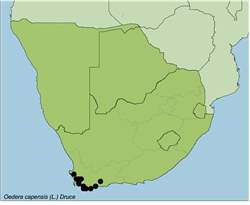Names and synonyms
Oedera capensis (L.) Druce
=Eroeda capensis (L.) Levyns
=Oedera prolifera L.f.
Derivation of names
Oedera = after George Christian Oeder (1728-1791), professor of Botany in Copenhagen, author of Flora Danica
capensis = from the Cape of Good Hope (South Africa)
Diagnostic characters
Involucral bracts densely or sparsely silky-hairy on the margins, sometimes only in the lower part
Involucral bract margins also with coarse triangular glands
Capitula in a large secondary head
Description
A diffuse, sparse, sprawling shrublet to 0.3 m; straggling prickly shrublet. Stems densely leafy, branching with 2-6 branches from below the previous seasons' capitulum. Leaves linear to lanceolate, broad and flat, broadest at the base, 5-25(-32) x 2-3(-6) mm, erect, spreading, reflexed or recurved, generally glabrous, glandular and silky-hairy on margins. Inflorescence terminal, composed of a number of capitula, mostly 9 but occasionally 10 or 11, grouped together in a secondary head, these heads 20-25(-40) mm in diameter; outermost row of florets radiate, occasionally with a few underdeveloped rays in the centre. Capitula mostly radiate with central capitulum mostly discoid. Involucral bracts of secondary heads in several rows, green and leaf-like, 2-3(-10) mm wide, lanceolate, broadest in the middle, with a prominent midrib, margins of inner leaf-like bracts densely, silky-hairy towards the base. Bracts around central capitula almost translucent, delicate and papery. Ray florets collectively between 30-40 in secondary heads, but 2-6 per capitulum radiating outwards, in an irregular single or double row; rays bright yellow or orange with reddish-purple underside. Disc florets yellow or orange. Pappus a crown of scales.
Flowering time
June to September (to October and even December).
Distribution
Cape Peninsula to Albertinia and Riversdale, and in the Little Karoo.
Known from more than 60 specimens.
Habitat
Dry stony flats and slopes, often on roadsides. Occasionally in sand on inland dunes.
Notes
In fresh specimens the ray florets of O. capensis are dark yellow to orange compared to the bright yellow florets in O. imbricata.
References
ANDERBERG, A.A. & BREMER, K. 1991. Parsimony analysis and cladistic reclassification of the Relhania generic group (Asteraceae - Gnaphalieae). Annals of the Missouri Botanical Garden 78: 1061-1072.
BEAN, A. & JOHNS, A. 2005. Stellenbosch to Hermanus. South African Wild Flower Guide 5. 2nd Edition. Botanical Society of South Africa.
BREMER, K. 1976. The genus Relhania (Compositae). Opera Botanica 40.
GLEN, H.F. 2004. SAPPI, What's in a Name? The Meanings of the Botanical Names of Trees. Jacana.
GOLDBLATT, P. & MANNING, J.C. 2000. Cape Plants. A conspectus of the Cape flora of South Africa. Strelitzia 9. SANBI.
HARVEY. 1865. Compositae in: W.H. Harvey & O.W. Sonder. Flora Capensis 3 (ed. 1). Hodges & Smith, Dublin.
KESTING, D. & CLARKE, H. 2008. Botanical names, what they mean. Wild Flowers of the Cape Peninsula, 3rd revised edition. Friends of Silvermine.
MANNING. J. 2007. Field Guide to Fynbos. Struik Publishers.
MUSTARD, P., COWLING, R. & ALBERTYN, J. 1997. Southern Overberg. South African Wildflower Guide 8. Botanical Society of South Africa.
PHILLIPS.1940. The Flowering Plants of South Africa 20: t. 786
SMITH, C. A. 1927. Four interesting species of Compositae. Bothalia 2: 360-365.
TRINDER-SMITH, T. 2006. Wild Flowers of Table Mountain National Park. South African Wild Flower Guide 12. Botanical Society of South Africa.
